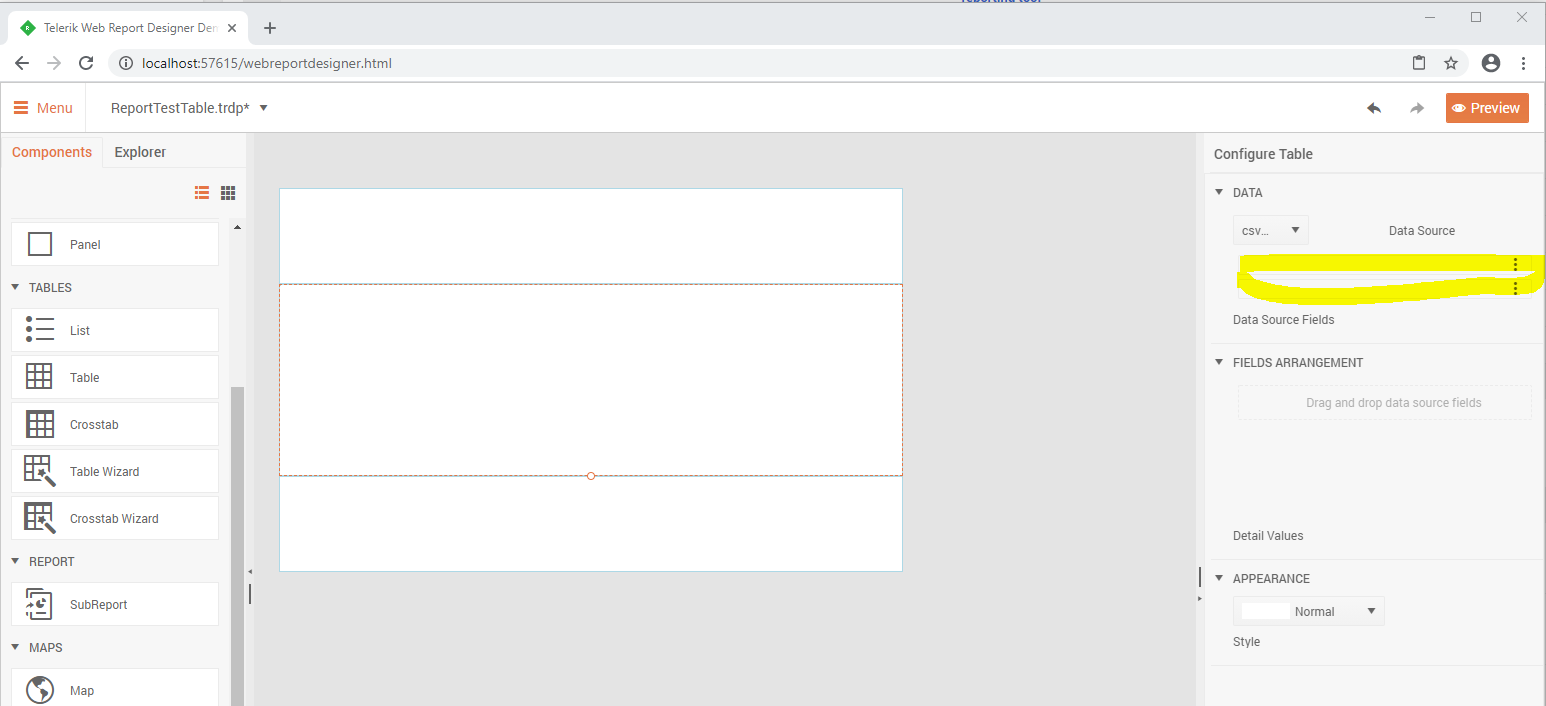Steps to reproduce the issue:
1. Create a new report in the WebReportDesigner;
2. Add a simple CSV DataSource (for example with Item and Value columns);
3. Select the Table Wizard and set the CSV DataSource as a Value of the DataSource property;
You will notice that the names of the columns from the datasource are missing.
Steps to reproduce:
1. Download and run the attached project in IE or Firefox
2. Write in the field for example "haha" and click the button.
3.Scroll down and you will notice that the headers are not frozen.
Steps to reproduce:
1.Download and run the project
2. If the scaleMode is FitPage, the report doesn't appear
3. If the scaleMode is FitPageWidth, the UI seems to be broken
You can check the attached video for further reference.
The SearchDialog is placed based upon a parent window of type "Window". However, when I use other types like "RadRibbonWindow" as my main window the placement does not work correct. As a result the SearchDialog is shown in the upper right corner of the desktop. This is the code (in SearchDialogController.cs):
Window GetParentWindow()
{
return (this.model.PageScrollViewer == null)
? null
: this.model.PageScrollViewer.FirstParentOfType<Window>();
}
At least this method should also take RadRibbonWindow in account (this is certainly not used that rarely since we all use Telerik components!) or for a more generic solution look for types that are derived from Window.
The path for window.kendo in initExpDeps.js is incorrect. This does not always lead to error. When there's an error it can be the following:
Module not found: Error: Can't resolve '.\telerikReportViewer.kendo.min'" in "ERROR in ./node_modules/@progress/telerik-angular-report-viewer/dist/dependencies/initExtDeps.js
private static ConcurrentDictionary<string, EsiInstanceReportSource> _irs = new ConcurrentDictionary<string, EsiInstanceReportSource>();The editor for parameters can be set for each type of parameter, but not individually for each parameter.
This means if there are two parameters that both have availableValues and have multiselect set to false, different editors can be set for each of these two parameters.
Exporting a report from the Report-Viewer to Word(docx), then opened in Word for Web (browser-version of Word) causes incorrect rendering of the document. Images are replaced with placeholders.
In comparison, exporting the report as PDF, then opening and converting it to Word and uploading it, renders much more correct and with images.
In .NET Core the localization routines have changed and the approach to localize an application provided in the documentation doesn't work.
When adding the localized .resx files as described in the documentation - with BuildAction set to None - the resource strings cannot be obtained and even the default string values are lost. This effect can be mitigated with changing the BuildAction to EmbeddedResource.
A possible solution would be to expose a ParametersAreaLoaded and ParametersAreaUpdated events with the needed arguments.
This will make migration from Silverlight easier. There the user has a direct access to them through the ReportViewerModel.
On numerous occasions I've found that the need to float or rearrange the designer windows such as the data explorer, properties or group explorer window would be very beneficial to my workflow.
As well this request should consider the ability of the data explorer and report explorer to be decoupled so as both can be visible simultaneously.
The parametersAreaVisible property of the angular report viewer allows controlling the visibility of the report parameters area.
Currently, this property can only be set. Reading the property doesn't reflect the current visibility of the report parameters area.
While jquery can be used as a work around to determine the visibility of the report parameters area (by reading the width of the corresponding DOM element), a proper angular API would be nice.

